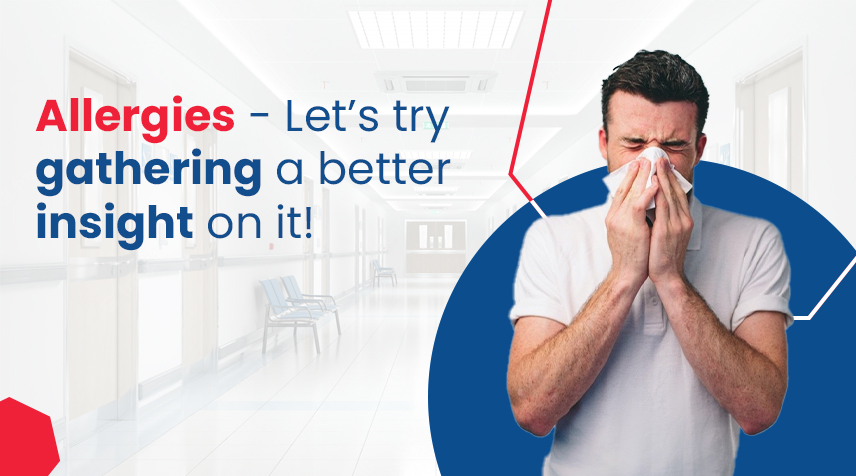Let’s try Gathering a Better Insight on it!
Allergies occur when your body reacts to an ordinarily harmless material that may be anything such as pollen, molds, animal dander, latex, certain foods and insect stings. And the symptoms of Allergies may range from slight – rash or hives, itchiness, runny nose, watery/red eyes – to serious or life-threatening. Treatments take account of antihistamines, decongestants, nasal steroids, asthma medicines and immunotherapy. To understand the entire concept and science of allergy, we have to primarily comprehend;
What are Allergies?
Allergies are your body’s reaction to a substance that it visions as a harmful “trespasser.” Let’s say, you might come across or in contact with a normally harmless substance either physically or environmentally such as pollen, molds or animal dander etc., which might cause your immune system (your body’s defence system) to bring out a reaction. These harmless substances that provoke reactions are called allergens.
What is Allergic Reaction?
An “allergic reaction” is the reactive way your body responds to the allergen. A series of events ensue that outcome in an allergic reaction.
If you are at risk to allergies, so at the primary exposure to any unambiguous allergen (such as pollen), your body responds by producing allergic (IgE) antibodies. The main labour of these antibodies is to discover the allergens and comfort you by removing them from your system. As a consequence, chemical so-called histamine is released and brings out different symptoms of allergies.
What are the Types of Allergies and how are They Treated?
You can be allergic to an extensive kind of ingredients such as pollen, mold, animal dander, and dust mites.
Pollen
Recurrent allergic rhinitis, or hay fever, is an allergic reaction that occurs when someone comes in contact to pollen. It effects in infection and inflammation of the nose lining and of the defending tissue of your eyes (conjunctiva).
Symptoms take in sneezing, congestion (feeling stuffy), and itchy, watery eyes, nose and mouth. Management alternatives consist of over-the-counter and prescription oral antihistamines, anti-leukotrienes, nasal steroids, nasal antihistamines, and nasal cromolyn. In a number of people, allergic asthma warning sign (wheezing, shortness of breath, coughing, and/ or chest tightness) can be triggered by exposure to pollen.
Your allergic symptoms may be abridged by avoiding pollen. Staying inside the house when pollen counts in the environment are in elevation, keeping your windows closed, and using air conditioners are all great ways to circumvent pollens and help you to make sure to have a respite from your allergy. If the allergy doesn’t fade away by taking these measures, then one must take advice from an allergist and healthcare provider about immunotherapy (“allergy shots”) to get relief from their pollen allergy.
Dust Mites
Dust mites are petite beasts that survive in dusts and in the fibres of household stuffs, such as cushions, pillows, mattresses, fitted carpet, and upholstery. Dust mites propagate in warm, humid areas.
The warning sign of allergy that occurs due to dust mites are analogous to those of pollen allergy. To comfort and cope dust mite allergies, shot using dust mite encasements (airtight plastic/polyurethane covers) above pillows, mattresses, and box springs. Also, remove carpet, or vacuum regularly with a high-efficiency filter vacuum cleaner. Allergy management may include medications to control your nasal/eye and chest allergic warning sign. Immunotherapy may be acclaimed if your indications are not sufficiently controlled with prevention techniques and medications.
Molds
Molds are petite fungi (like Penicillium) with spores that glide in the air like pollen. Mold is a common trigger for allergies. Mold can originate indoors in moist and damp areas, such as the basement, kitchen, or bathroom, in addition to outdoors in grass, leaf piles, hay, and mulch or beneath mushrooms. Mold spores spread highest for the period of hot and humid weather.
Treatment may take in medications to control your nasal/eye and chest warning sign. Immunotherapy may be suggested if obstinate symptoms are not satisfactorily controlled with avoidance and medications.
Animal Dander
Allergic reactions can be caused by the proteins secreted by sweat glands in an animal’s skin, which are shed in dander, and by the proteins in an animal’s saliva. Avoidance measures don’t work as well as simply removing the pet from your home. However, because many people are reluctant to do this, second-best measures include keeping your pet out of your bedroom, using air cleaners with HEPA filtration and washing your pet (cat or dog) frequently.
Treatment may include medications to control your nasal/eye and chest symptoms. Immunotherapy may be recommended if your symptoms are not satisfactorily controlled with avoidance procedures and medications.
Latex
Some individuals develop a latex allergy after recurrent contact with latex. Rubber gloves, such as those employed in surgical procedure or home cleaning, are most important basis for triggering this sort of allergic response. Skin rash, hives, eye tearing and irritation, wheezing and itching of the skin may come about if you have developed a latex allergy.
Allergic reactions to latex can be mild, such as skin redness and itching. Further extreme responses can arise if your mucosal membranes are exposed, such as during a procedure or a dental or gynaecologic examination.
Treatment of latex reactions initiates by getting rid of the aberrant latex product. If case you have latex allergy, it is significant for you to wear a Medic Alert® band and carry a backup epinephrine kit. Altogether actions would better be carried out in a “latex-safe” fashion. There is no treatment for latex allergy, so the best treatment for this ailment is prevention and avoidance of coming in contact to these allergic materials.
Certain Doods
Food allergies advance when your body develops a specific antibody to a specific food. An allergic reaction arises within minutes of consuming the food, and warning signs can be severe. In adults, the most popular food allergies are shellfish, peanuts and tree nuts. In kids, they may be related to milk, egg, soy, wheat, shellfish, peanuts and tree nuts.
If suppose you have got a food allergy, your indication signs might include itching, hives, nausea, vomiting, diarrhoea, breathing complications and inflammation around the mouth area.
It is tremendously significant to dodge the foods that reason for these allergy signs. If any adult or kid has a particular food allergy, then the allergist of the specialist may recommend injectable epinephrine (adrenaline) for backup (emergency) to carry along at all times. This is required in case an individual by accident consume any food that might trigger the allergy. There are innovative treatments for peanut allergies termed as oral immunotherapy.
Insect Venom (stings)
In a condition where you get at a bee sting, a usual reaction includes pain, inflammation and soreness around the sting spot. A bulky, local response might result in an inflammation that outspreads beyond the sting spot. For example, if you are nipped on the ankle, you might experience a swelling on your entire leg.
Allergies in Different Seasons
Principally there is no therapy, but certain measures might be taken so as to reduce your allergy warning sign in the spring time, from medication to modifying your lifestyle.
Allergies in the Summer
Pollen arising from grasses and weeds is the most common source of summer allergies.
Allergies in the Fall
In the fall season, the most popular allergy triggers are ragweed, mold, and dust mites.
Allergies in the Winter
If an individual is allergic to mold or dust mites, one might experience amplified warning sign in the winter season when you spend more time indoors.
The most serious reaction to an insect sting is an allergic one, which needs immediate medical attention. Symptoms of an allergic reaction to an insect sting include:
- Difficulty in breathing
- Widespread (extensive) hives that appear as a inflamed, itchy rash that spreads to parts other than the area that was bee stung.
- Inflammation on face, throat or mouth tissue.
- Wheezing or trouble swallowing.
- Restlessness and anxiety.
- Rapid pulse.
- Dizziness or a strident drop in your blood pressure.
- If you have a reaction like this, a re-sting can cause a serious reaction that can be life-threatening.
An allergic reaction is treated with epinephrine (adrenaline). If you’ve had an allergic reaction to bee stings, see a board-certified accredited allergist/immunologist to get a skin and/or blood test to check your allergy to bee venom. Venom immunotherapy is suggested in the cases when venom allergy is confirmed. This will aid to reduce the prospect that a re-sting will eventually bring out a serious reaction.
What is Allergic Rhinitis?
Nasal allergy indications and hay fever are referred to as “allergic rhinitis.” Seasonal allergic rhinitis is nasal allergies that vary with the changing seasons because of pollen from plants (trees, grasses, or weeds). Seasonal warning indications arise all through the cross-pollinating seasons for particular vegetation. Since an individual can be allergic to more than one substance or material, your indicators may get worse across the various seasons throughout the year, or may be persistent.
Does Everyone get Allergies?
No. Most of the allergies are genetic, which means they are further passed on to kids by their parents. Individuals inherit an inclination to be allergic, even though not to any specific allergen. If your child develops an allergy, it is surely possible that you or your companion has allergies.
How Common are Allergies?
Over 50 million American population (1 in 6) suffer one or another sort of allergy, that includes altogether the indoor/outdoor allergies, food and drug, latex, insect, skin and eye allergies. The total count of people who experience any sort of allergy remains increasing across all ages, sex and racial sets.
SYMPTOMS AND CAUSES
What are the Symptoms of Allergies?
Allergy warning indications are classified as mild, moderate or severe:
Mild reactions comprise warning symptoms (affecting a particular part of your body) like a rash or itchiness, hives, hay fever, watery/red eyes, and runny nose. Mild reactions do not extend and escalate over other parts of your body.
Moderate reactions include signs that spread to different parts of your body. Symptoms might comprise of itchiness, and/or inflammation, rashes and distress breathing.
Anaphylaxis, a severe allergic reaction, is a sporadic, lethal emergency in which your body’s reaction to the allergen is abrupt and distresses the entire body. Anaphylaxis may initiate with acute itching of your eyes or face. And in just a few minutes, more severe indications appear, that might include symptoms such as throat inflammation (which may perhaps cause hitches in swallowing and breathing), stomach ache, cramps, vomiting, diarrhoea, hives and inflammation (angioedema). You might also experience a state of mental muddle or vertigo, since anaphylaxis may cause a drop-in normal blood pressure rate.
What Causes Allergies?
Anything that you come into contact with that your body views as a “harmful invader” can be a cause of an allergy. Normally harmless substances that are common causes of allergies include pollen, animal dander, mold, dust, foods, insect venom and latex
Technically, your allergy symptoms are the outcome of a series of events that are your body’s reaction to the “harmful intruder.” The body “perceives” the trespasser, makes antibodies to contest the intruder, and simultaneously while doing so, releases histamines that root for the symptoms of allergy.
DIAGNOSIS AND TESTS
How are Allergies Diagnosed?
If you realise that you have catch any sort of allergy, then don’t delay waiting for your symptoms to vanish completely. When your indications stretch longer than a week or two and have a tendency to to arise back, make an appointment with a professional allergist/immunology.
Skin testing for allergy may be used to recognize the allergens that are triggering your allergy symptoms. The allergy test is executed by pricking your skin with an extract of an allergen, and then examining the reaction on skin. In the cases where a skin test can’t be carried out, blood test might be attained. The latter test is not as delicate as a skin test. The test estimates the total number of antibodies produced by body’s immune system. Higher levels of particular antibodies recommend probable allergy to that allergen.
Additional kinds of allergy testing are existing too.
Treatment for Allergies
Avoiding allergen is the finest treatment tactic. Apart from this, the medicines suggested for the treatment of allergies are:
- Anti-histamines
- Decongestants
- Nasal steroid sprays and nasal antihistamines.
Few popular asthma drugs that are used to cure allergies are:
- Inhaled steroids
- Devices with bronchodilators
- Oral Bronchodilators
- Anti-leukotrienes
- Reslizumab, omalizumab, benralizumab or mepolizumab injections
Immunotherapy also known as allergy shot therapy is an oral therapy that has proven actively effective in countering allergic asthma or allergic rhinitis.
Saline irrigation is yet another effective method of treatment. This method comprises where saline solution is used to rinse the nasal cavity with the aid of a pump, or a spray or nebulizer etc.
Natural Remedies for Allergies
1. Vitamin C
An antioxidant that majorly benefits in building stronger and better immunity. Adding a recommended shot of vitamin C in the everyday routine, helps in reducing the levels of histamine in the body. Concentrated levels of histamine diminish the necessity for anti-histamines in the body that are drugs recommended for the treatment of allergies.
2. Bromelain
A specific enzyme known as Bromelain, that is available from fruits such as pineapple and ripe papaya may be advised as a relief or cure for few allergies. This enzyme is a natural healer, that helps in reduction of inflammation and rashes, and recover breathing. In the larger picture this helps in reducing the symptoms of allergy to provide relief.
3. Probiotics
Probiotics are popular healthy bacteria that helps in maintaining a healthy gut. Probiotics are readily accessible in the market in the form of curd/ yoghurt. Furthermore, Lactobacillus in probiotics supports to diminish the allergic rhinitis, as proven by prime researches across the world.
4. Eucalyptus Oil
For centuries, eucalyptus has been popularly known and established for its therapeutic properties. Furthermore, it is an anti-microbial and can be supplemented along with washing detergent while laundry all through allergy season.
5. Peppermint Oil
It has its widespread usage in several medication formulation owing to its medicinal properties. Furthermore, attributable to its anti-inflammatory effects, it reduces the symptoms of asthma and allergic rhinitis. It is generally topically applied, after being diluted with a common oil or gently inhaled by diffusing it in the air.
Diagnosis of Allergies
Allergy skin testing is basically completed by smearing a globule of different allergens on top of your skin and then realising which one is sensitive against your body. Qualitative analysis is carried out for set of an array of allergens by testing serum samples. Skin test, prick test, blood test etc. least of two categories of investigation is crucial to be certain about a specific sort of allergy. Not a single test can give sure shot reliable results.
Prevention of Allergies
Prevention of allergic reactions be reliant on the sort of allergy that you have. Given below are few of the standard prevention methods.
1. Keep one’s distance from known triggers.
You have to distinguish the entity that you are allergic to and keep one’s distance from it. In case, if you are sensitive to dust and dirt, you at all times must remain in a hygienic and germ-free milieu. Otherwise, if suppose you are hypersensitive (allergic) to prawns, then you must not even once eat prawns or be overly cautious while placing your food order.
2. Maintain a book or diary.
When recognizing the root-cause of allergy, maintain a note about the places you are visiting and what you are consuming. So, if in a certain case your body reacts aggressively, you can always track and check the item that you are allergic to which triggered the allergic reaction.
Foods that Fight Allergies
1. Bioflavonoids
They execute as mast–cell stabilisers by reducing the total number of cells reacting to an allergen. Mast–cells release histamine, which roots allergies in the body. Hence, they reactive counter to histamines and offer relief from irritating allergies. Food that has active bioflavonoids are apple, onions, tea, red wine etc.
2. Sinus Clearing Spices
Sinus clearing food species comprise of star anise, fennel seeds, horseradish, and hot mustard. All these spices are natural decongestants that helps in fighting congestion that aggravates as a consequence of allergy.
3. Vitamin E Rich Foods
Gamma–tocopherol in vitamin E rich foods stretches relief against the anti-inflammatory sort of allergies. It lessens swelling and redness in the nasal cavity and offers relief from a runny and irritated nose. Vitamin E rich nutrients are sunflower oil, soybean oil, red bell pepper, pumpkin sunflower seeds etc.
4. Magnesium-Rich Foods
Magnesium behaves as an antihistamine and a bronchodilator in your system. Accordingly, these foods have a soothing effect on the entire body and specifically the muscles. Food sources that have high magnesium content are almonds, cashew nuts, wheat bran etc.
5. Coldwater Fish
Salmon fish is a cold-water fish. It is rich in Omega-3 fatty acid, that has its anti-inflammatory properties and offers relief against allergy.
Bottom Line
You can avert all sort of allergies by ensuing a diet rich in anti-allergy nutrients and following routine medications if required. In case of a reaction to a specific food that one is sensitive to, an individual must refer a specialist instantly and not depend completely on home remedies. Allergic reactions can be devastating if not paid consideration to in the long run. Nevertheless, cognizance and appropriate diagnosis can support to address them and stall their advancement. Therefore, be alert and diagnose the triggers and seek out for assistance at the very beginning.


